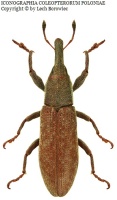
Русские, остановите эту войну! Спасите Свободную Украину!
Russians, stop this war! Save Free Ukraine!
Biodiversity Map
Taxa

Dilixellus — subordinate taxa:
Taxon count: 6
-
Lixus bardanaeSet as tree root ↑
Show taxon data → ⚑
 [150] → Show taxon data
[150] → Show taxon data -
Lixus fasciculatusSet as tree root ↑
Show taxon data → ⚑ [23] → Show taxon data
[23] → Show taxon data -
Lixus pulverulentusSet as tree root ↑
Show taxon data → ⚑
 [75] → Show taxon data
[75] → Show taxon data -
Lixus punctiventrisSet as tree root ↑
Show taxon data → ⚑ [45] → Show taxon data
[45] → Show taxon data -
Lixus rubicundusSet as tree root ↑
Show taxon data → ⚑ [4] → Show taxon data
[4] → Show taxon data -
Lixus vilisSet as tree root ↑
Show taxon data → ⚑ [13] → Show taxon data
[13] → Show taxon data
-
Arthropodaphylum
Click to switch
to select orders
and filters > -
Hexapodasubphylum
Click to switch
to select orders
and filters > -
Insectaclass
Click to switch
to select orders
and filters > -
Coleopteraorder
Click to set
as the main taxon
and as a base
← of the left panel > -
Polyphagasuborder
Click to set
as the main taxon
and as a base
← of the left panel > -
Cucujiformiaseries
Click to set
as the main taxon
and as a base
← of the left panel > -
Curculionoideasuperfamily
Click to set
as the main taxon
and as a base
← of the left panel > -
Curculionidaefamily
Click to set
as the main taxon
and as a base
← of the left panel > -
Lixinaesubfamily
Click to set
as the main taxon
and as a base
← of the left panel > -
Lixinitribe
Click to set
as the main taxon
and as a base
← of the left panel > -
Lixusgenus
Click to set
as the main taxon
and as a base
← of the left panel > -
Dilixellussubgenus
Click to set
as the main taxon
and as a base
← of the left panel >
PL
YES
name status: valid name
BioMap ID: 1046894
taxon code: 5170
taxonomy checked: YES
Data on distribution in Poland

Statistics
- Records: 13
- Publications: 13
- Collections: no data
- Publication authors: 13
- Illustrations (iconography): 1
- Photos (specimen/observation): lacking
Taxon description
Gatunek rozprzestrzeniony od Kaukazu i Azji Mniejszej przez kraje śródziemnomorskie aż po południowe części środkowej Europy. W Polsce ryjkowiec mało znany, od 70 lat u nas nie poławiany; notowano go tylko z jednego stanowiska na Śląsku Dolnym i na tej podstawie wykazywany ogólnikowo ze Śląska. Wzmianka sprzed 120 lat o występowaniu w okolicach Tarnowa winna być potwierdzona nowymi materiałami. Zasiedla nasłonecznione zbocza, piaszczyste pola, przydroża i miejsca o charakterze ruderalnym. Larwa żeruje i odbywa rozwój w szyi korzeniowej iglicy pospolitej — Erodium cicutarium (L.) L’Hérit. Postacie dojrzałe występują od kwietnia do października, w ciągu dnia zwykle przebywając na glebie pod przyziemnymi liśćmi. Chrząszcze spotykano głównie na iglicy pospolitej, rzadziej na janowcach — Genista L., ostach — Carduus L. i dębach — Quercus L.
Illustrations
... browse
 Lixus
Lixusvilis
External data sources
- Ostatnie rekordy
-
187253
 ×
× Curculionidae: Lixus vilis, PL, «Brama Morawska» (Petryszak 1982, Burakowski et al. 1993)
Curculionidae: Lixus vilis, PL, «Brama Morawska» (Petryszak 1982, Burakowski et al. 1993) -
187252
 ×
× Curculionidae: Lixus vilis, PL, «Galicja zachodnia» (Nowicki 1873b, Burakowski et al. 1993)
Curculionidae: Lixus vilis, PL, «Galicja zachodnia» (Nowicki 1873b, Burakowski et al. 1993) -
187251
 ×
× Curculionidae: Lixus vilis, PL, «Galicja» (Łomnicki 1884a, Burakowski et al. 1993)
Curculionidae: Lixus vilis, PL, «Galicja» (Łomnicki 1884a, Burakowski et al. 1993) -
187250
 ⊡
⊡ Curculionidae: Lixus vilis, PL, Nizina Sandomierska, ad Tarnów, UTM DA93 (Viertl 1872, Burakowski et al. 1993)
Curculionidae: Lixus vilis, PL, Nizina Sandomierska, ad Tarnów, UTM DA93 (Viertl 1872, Burakowski et al. 1993) -
187249
 ⊡
⊡ Curculionidae: Lixus vilis, PL, Dolny Śląsk, Legnica, UTM WS87 (Kolbe 1924, Burakowski et al. 1993)
Curculionidae: Lixus vilis, PL, Dolny Śląsk, Legnica, UTM WS87 (Kolbe 1924, Burakowski et al. 1993) -
145899
 ×
× Curculionidae: Lixus vilis, PL, «Śląsk» (Lohse 1983, Burakowski et al. 1993)
Curculionidae: Lixus vilis, PL, «Śląsk» (Lohse 1983, Burakowski et al. 1993) -
145898
 ×
× Curculionidae: Lixus vilis, PL, «Śląsk» (Dieckmann 1983b, Burakowski et al. 1993)
Curculionidae: Lixus vilis, PL, «Śląsk» (Dieckmann 1983b, Burakowski et al. 1993) -
145897
 ×
× Curculionidae: Lixus vilis, PL, «Śląsk» (Petryszak 1982, Burakowski et al. 1993)
Curculionidae: Lixus vilis, PL, «Śląsk» (Petryszak 1982, Burakowski et al. 1993) -
145896
 ×
× Curculionidae: Lixus vilis, PL, «Śląsk» (Smreczyński 1968b, Burakowski et al. 1993)
Curculionidae: Lixus vilis, PL, «Śląsk» (Smreczyński 1968b, Burakowski et al. 1993) -
145895
 ×
× Curculionidae: Lixus vilis, PL, «Śląsk» (Horion 1951, Burakowski et al. 1993)
Curculionidae: Lixus vilis, PL, «Śląsk» (Horion 1951, Burakowski et al. 1993) - ... more
- Powiązane publikacje
-
Burakowski B., Mroczkowski M., Stefańska J. 1993. Chrząszcze – Coleoptera. Ryjkowce – Curculionidae, część 1. Katalog Fauny Polski, XXIII, 19, Warszawa.
 Show records
Show records -
Mroczkowski M., Stefańska J. 1991. Coleoptera – Chrząszcze. [In:] Razowski J. (Ed.) Wykaz Zwierząt Polski. Tom III, Część XXXII/22, 23, Insecta: Coleoptera, Strepsiptera. Krakowskie Wydawnictwo Zoologiczne. pp. 7-197.
 Show records
Show records -
Lucht W.H. 1987. Die Käfer Mitteleuropas, Katalog. Krefeld. 342 pp.
 Show records
Show records -
Lohse G.A. 1983. Cleoninae, Tanyrhynchinae, Raymondionyminae, Stenopelminae, Bagoinae, Tanysphyrinae, Notarinae, Curculioninae, Pissodinae, Acicnemidinae, Rhynchophorinae, Barinae, Zygopinae, Ceutorhynchinae, Nanophyinae, Anoplinae, Rhynchaeninae. [In:] Freude H., Harde K.W., Lohse G.A. (Eds.) Die Käfer Mitteleuropas. Band 11. Krefeld. pp. 7-29, 43-121, 157-159, 171-259, 283-294.
 Show records
Show records -
Dieckmann L. 1983b. Beiträge zur Insektenfauna der DDR: Coleoptera – Curculionidae (Tanymecinae, Leptopiinae, Cleoninae, Tanyrhynchinae, Cossoninae, Raymondionyminae, Bagoinae, Tanysphyrinae). Beitr. Ent., 33:257-381.
 Show records
Show records - ... more




